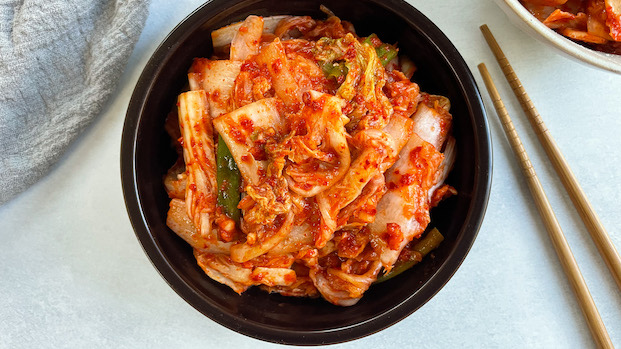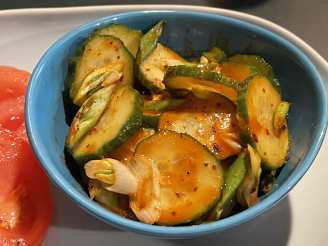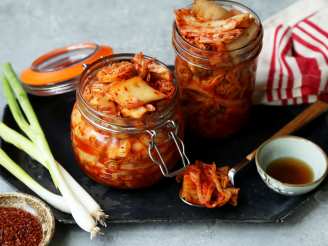Kimchi

- Ready In:
- 2hrs 5mins
- Ingredients:
- 10
- Yields:
-
2 jars
- Serves:
- 50
ingredients
- 2 large head napa cabbage (approx. 7 lbs)
- 1⁄2 - 2⁄3 cup kosher salt (please be aware that different types of salt have different "saltiness" levels)
- 1⁄2 cup sweet rice flour
- 3 cups water
- 1 cup , coarse gochugaru (you can use up to 2 cups depending on your heat tolerance, do not use any other substitutes. Korean )
- 4 scallions (cut on bias)
- 2 tablespoons fish sauce
- 6 -8 tablespoons white sugar
- 6 large garlic cloves, minced
- 1 -2 tablespoon fresh ginger, grated
directions
- Start this in the evening.
- Wash your kitchen sink well with soap and then put the plug in.Run the cool water.
- Trim off any yellowed or unattractive parts of the napa.
- Cut each cabbage in 1/4 at the root end. cut off the tough root at an angle and cut the leaves into large bit size pieces then place all of this into the sink. Throw the tough root away.
- Keep going until all of the cabbage in in the sink. Rinse the cabbage well and then use hands or a colander to drain the cabbage slightly and place into very large bowls.
- Follow the previous step once more until you are sure that the cabbage is very clean.
- Evenly sprinkle the 1/2 cup salt over the cabbage and try to toss the best you can.
- Once before you go to bed toss the cabbage again to evenly distribute the saltly water that is being made.
- In the morning toss the cabbage again. You should notice that the cabbage has shrunk by 1/3 or maybe 1/2 at most.
- Taste the salty water that has collected. It should be salty but not to the point you wouldn't want to taste it again. If it doesn't seem saltly enough add a few more Tablespoons of salt.
- Now check the cabbage. Take a piece of the thick white part and bend it. It should give, but not be soft. Salting takes 10-14 hours.
- Next prepare the flour porridge. Put 3 cups cold water and the 1/2 cup sweet rice flour in a large saucepan over med-high heat. STIR constantly. Once it is boiling and has thicken significantly keep stirring and cooking it for 1 more minute.
- Take the flour porridge off the heat and cool completely.
- Once the porridge has cooled completely to room temperature, put the rest of the ingredients in to the large saucepan and combine well. Stir for a few minutes to draw out the red color of the gochugaru.
- Wearing rubber gloves or some other kind of protective glove, pour the sauce mixture over the cabbage and rub it in well. Not just mix it. You much rub it so that every piece of cabbage has been coated. This rubbing will encourage the red color too.
- Taste a small piece of kimchi. It has not fermented yet, but see if you feel it lacks something. Whether salt or sugar. Adjust if you need to.
- Place the unfermented cabbage into 2 large kimchi jars with tightfitting tops. Press down the cabbage leaving space at the top. This will keep the kimchi juice from overflowing when it ferments. put a piece of plastic wrap over the top and then screw on the lid.
- Place one jar into the back of your fridge. You can take this one out and ferment it when the first jar is done.
- Place one jar on the counter on top of a plate with a lip (this catches any possible overflows) for 1-2 days. After 1 day, take a piece out and taste to see if you like the level of fermentation. If not try another piece after 1/2 day or 1 day. 2 days should be the maximum time it takes. Each time you open the jar, press down the cabbage because the bubbles from the fermentation will cause the cabbage to lift out of the liquid. After you are satisfied with the fermentation level, place the jar into the fridge and enjoy.
- After the kimchi has become to soft for you to enjoy eating raw, it is perfect for cooked applications. Do not throw it away. This does not rot easily unless you contaminate the jar.
Questions & Replies
Got a question?
Share it with the community!
Reviews
-
This is a wonderful kimchi! Very, very easy to make. I did make a mistake of using not too fresh gochugaru which made my kimchi not bright red, but the taste was right on. I never saw the bubbles from fermentation but after 3 days on the counter, I decided the taste was developed and mellowed. Thank you Grace for posting this recipe. I plan on making this often and I'm sure my results will improve with time.
RECIPE SUBMITTED BY
I love cooking, baking and eating all kinds of food. I am an avid watcher of cooking shows and love cookbooks, recipe websites, etc... you name it.




